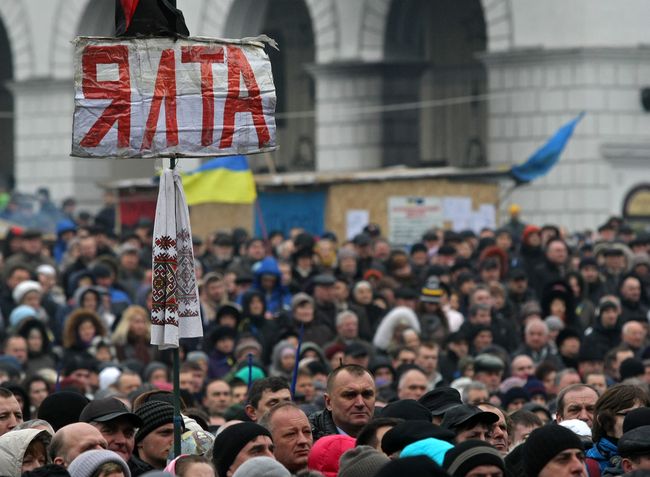February 20, 2014: the situation on the Maidan reaches its peak, with people being shot point-blank in downtown Kyiv. The capital is blocked by law enforcement units, the Metro is closed, with outside web cameras showing the scene on various sides, and broadcasting it worldwide. The Kremlin says it is a civil conflict in Ukraine while the Olympiad in Sochi is underway, to end on February 23. A week later, Russia will start a combat operation to annex Crimea. A medal reading, “For the Return of Crimea” will be instituted, with the dates 10 February 2014 – 18 March 2014 on the reverse side. The first date is graphic proof that there was no “civil war,” but a phase in an occupation project while people were killed en masse on the Maidan. It stands to reason that those mass killings marked the beginning of Russia’s occupation.
Crimea was annexed, and this disturbed the international community. In the meantime, Russia was getting ready in Donbas, hiring mercenaries, local military units, law enforcement personnel, and officials. Fake referendums were staged, Kalashnikovs were handed out free to those with passports. There was an information vacuum. That was the second stage of occupation, and the Grad truck-mounted multiple rocket launchers and tanks followed.
The Verkhovna Rada of the previous convocation had the time to recognize Crimea as an occupied territory, but the next parliament did not follow suit with regard to the terrorist-occupied Donbas. That fact remained on posters and in political speeches.
What do we have today? The attempts to blockade the occupied territories initiated by some politicians have often been nonsystemic and thus hardly effective. There are political prisoners and other civilians in the occupied territories, who are persecuted by the Russian authorities. People are arrested and accused with false charges of terrorism, as in the times of Stalin.

PLACARD READS: “YALTA” / Photo by Mykola TYMCHENKO, The Day
The big question is whether official Kyiv has a clear cut strategy for the deoccupation and reintegration of Crimea and the occupied part of Donbas. What has the political leadership done in order to get back these territories? Could the current ambiguous top level official stand give an impetus to various speculative versions and ideas that strongly resemble Russian scenarios?
Andrii Klymenko, editor-in-chief of www.blackseanews.net, told The Day: “The absence of a quality official policy and strategy, concerning the occupied territories of Crimea and Donbas, is the main reason behind the appearance, in this information vacuum, of various speculative theories and proposals, like Pinchuk’s articles and Artemenko’s statements. Everything that has been done with regard to Crimea is due to public pressure. The current situation is like that at the end of 2015, when the civil blockade of Crimea forced the government to stop trade with the occupied territory, including electricity supply. Public activists have for two years been campaigning for the nullification of the cabinet’s resolution that forbids residents of Crimea, who wish to resettle in mainland Ukraine, to bring with them their property ranging from books to pieces of furniture to office equipment. This is an obstacle for the Ukrainian nationals who want to return to Ukraine.
“I must admit that we, members of the NGOs, have long stopped having any expectations of our government. We are making a coordinated effort and what we achieve is only by using our own resources. Also, the current attempt to blockade trade with the occupied territories of Donbas is meeting with more problems than the blockade of Crimea, although the reasons behind them are the same. The difference is that the bill on the occupied territories of Crimea and Sevastopol was passed before Petro Poroshenko became President.
“At the time, the organizers of the blockade of Crimea had a stronger legal basis. However, both the blockade of Crimea and that of the occupied part of Donbas reveal the same problem. A considerable part of Ukraine’s big business and business-affiliated politicians want profits from doing business with the occupied territories. To these people, human rights and the returning of people to these territories make no sense.”
Populist politicians, mammonistic oligarchs, and agents provocateurs remain an inner weak spot in our struggle against the Kremlin, and the enemy will keep zeroing in on this target. This war started not with tanks, but with gradual brainwashing, probing our weak spots. This reminds me of George Shevelov’s article “Moscow, Maroseika” [Boston, 1954] about three dangers for Ukrainians: Moscow, provincialism, and Kochubei-mentality complex [Vasyl Kochubei (1640-1708) was a Ukrainian nobleman and statesman of Tatar descent, chief judge and stolnik (a rank immediately below that of boyar) of the Cossack Hetmanate who felt insulted by 63-year-old Ivan Mazepa’s affair with his daughter, 20, who was Mazepa’s goddaughter, whereupon he distanced himself from the Ukrainian hetman and repeatedly warned Peter I of Russia about Mazepa’s secret intention to break away from Russia. – Ed.]. He also warned of Russia’s advances against our national identity.








